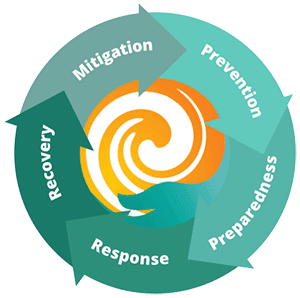
Safeguarding Success
The Importance of Workplace Disaster Preparedness
In an increasingly uncertain world, workplace disaster preparedness has emerged as an indispensable priority for organizations. Natural disasters, technological failures, workplace accidents, multi casualty scenarios, and other unforeseen events can, and do, disrupt operations, jeopardize employee safety, and cause severe financial losses. In addition, these sorts of events can literally destroy an organizations “culture” overnight.

Implementing robust disaster preparedness measures is vital for ensuring business continuity, protecting employees, and minimizing the impact of these unforeseen events upon your organizational and safety cultures.
Here are some of the key reasons why you should be talking to Transformational Safety about all the things we can do to both minimize the likelihood of you experiencing a disaster (reduce frequency) along with your ability to recover from any disaster with as minimal damage as possible from that exposure – both corporate and people (resilience).
Ensuring Employee Safety and Well-being
The safety and well-being of employees should be paramount for every organization. By implementing comprehensive disaster preparedness plans, companies can reduce the risks posed to their workforce during emergencies.
A disaster prepared workplace not only minimizes physical harm but also provides psychological support to employees, along with +fostering a sense of security and trust. Many organizations manage the mechanics of disasters reasonably well eg, calling ambulances and sending flowers. Where they nearly all fall down is the preparedness of “people” for a disaster. It is this space where Transformational Safety is a global leader in assisting organizations develop and integrate people-focussed disaster management best practice interventions.
Maintaining Business Continuity
Disasters disrupt operations and almost always result in significant downtime, leading to substantial financial losses. Organizations that invest in (and practice) disaster preparedness measures can mitigate the impact of such events and ensure the continuity of their business operations.
Protecting Infrastructure and Assets
Disasters can cause extensive damage to physical infrastructure, equipment, and valuable assets. Effective disaster preparedness helps safeguard these resources, reducing the risk of irreparable losses. By conducting risk assessments, implementing preventive measures, and maintaining appropriate insurance coverage, organizations can mitigate the financial burden of repairing or replacing damaged assets. Protecting infrastructure not only ensures the smooth functioning of the workplace but also minimizes disruptions to supply chains, enabling timely delivery of products and services to customers.
Enhancing Organizational Resilience
Disaster preparedness fosters organizational resilience, enabling organizations to bounce back from the “bad stuff” more effectively. A well practiced and prepared workplace encourages a proactive and adaptable mindset, ensuring that employees and leadership are ready to face the unforeseen challenges that workplace disasters always bring. By establishing clear communication channels, empowering employees to make informed decisions, and conducting regular drills and simulations, organizations can build a culture of resilience. This adaptability enables teams to respond swiftly and efficiently during crises, reducing panic, chaos and chronic loss.
Meeting Regulatory and Legal Obligations
In many jurisdictions, workplace disaster preparedness is not just a matter of choice; it is a legal requirement. Governments and regulatory bodies have introduced guidelines and regulations to ensure the safety and well-being of employees during emergencies. Compliance with these regulations is crucial for organizations to avoid penalties, lawsuits, and reputational damage. By prioritizing disaster preparedness, companies can demonstrate their commitment to fulfilling legal obligations and maintaining a safe working environment.
Conclusion
Investing in workplace disaster preparedness is not just a prudent business decision; it is an ethical responsibility.
It is just the right thing to do!
By prioritizing employee safety, ensuring business continuity, protecting assets, fostering resilience, and meeting regulatory obligations, organizations can safeguard their success and contribute to the well-being of their employees and communities.
Embracing disaster preparedness as a fundamental aspect of corporate culture empowers businesses to navigate the uncertainties of today’s world with confidence, positioning them for long-term sustainability and growth.
As part of Transformational Safety’s ongoing comitment to disaster preparedness we have decided to make available, for free, the Workplace Trauma Handbook. To obtain your copy just click here. This has become the most popular document that we have ever produced. Feel free to forward a copy to whomever you think might find value in the content.
If you would like to take a look at how one organization is leveraging Industry 4.0 technologies as a platform to support disaster preparedness then just click here.

Ricky, Atlanta
![]()
“I was fortunate to attend Transformational Safety’s Anatomies of Disaster Program. This was amongst the most powerful two days I have ever spent in a room. From the outset David Broadbent set the scene by dedicating the program to the late Rick Rescorla – the man who is credited with saving over 2700 lives on 9/11. Throughout the two days David would often respectively reflect and remember those who had died, or been injured, in the disasters we explored. He would say, and I will never forget, “…we must always remember those that lost their lives lift us up into the light of understanding”. I learnt so much. HRO, Resilience Engineering, Critical Incident Stress Management (CISM) and more. Those of us who were there are still talking about it…… Thankyou David


